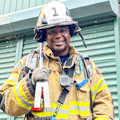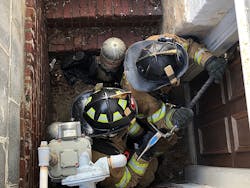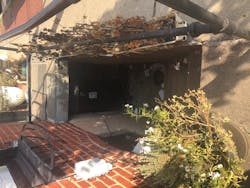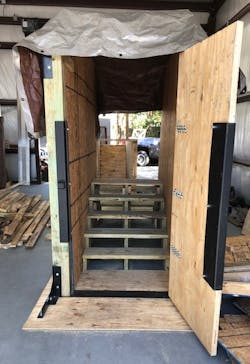Our most important task is getting a fireground full of people through the initial entry door quickly. That said, once the basics of forcible entry are mastered, you should push yourself to deal with more realistic challenges, and one of those realistic challenges is the ability to force doors in tight and confined spaces.
It doesn’t matter whether it’s a big city, a small town or a borough: Doors that you encounter in the heat of the moment can be in the least favorable positions, with the most challenging locks, leaving you to adapt and overcome. This puts your tools and your body in the most awkward positions.
Tight space forcible entry tactics are broken into three major components:
- Tools and their practicality, functionality and state of readiness, particularly your Halligan
- The entry door’s workable space and the dangers that are in that space
- Proactive and aggressive entry tactics
Tool preparation is the most important consideration prior to forcing any entry door. Tools should be clean, tuned and functional. With good maintenance habits, forcible entry tactics are much easier to navigate, particularly when dealing with tight spaces.
What is a tuned Halligan? A tuned Halligan is one that members worked on using a file or angle grinder to enable the Halligan to better fit and function in difficult spots. Some—not all—fire tool distributors make Halligans that already are tuned.
Although you can’t set up your Halligan for every possible scenario, it’s important that you have it ready for most of the common encounters, including:
Jamb-lines: Markings etched, ground or drawn on the Halligan’s forks and adze help to identify whether the Halligan is in far enough between the frame and the door before pushing or pulling on the tool to get the door’s lock to pop.
Squared shoulders: 90-degree cuts (L-shaped) taken from the standard rounded shoulders on the Halligan allow these corners to serve as striking surfaces to a flathead axe as its driven down the shaft of the Halligan. Striking the shoulders allows you to drive the forks into position while working in tight spaces. (Note: Because of the contour of sledgehammers, they don’t work in sliding down the shaft of the Halligan to the shoulders that are squared off.)
Thinned forks: Metal from the tips of the forks is ground down using a file or an angle grinder with a cutting wheel, so the tips are easier to get into tighter doors or frames.
Unwrapped shafts: The shaft of the Halligan isn’t wrapped with any material to make handgrips. Hockey tape or other commercial products can be spiraled around the shaft to provide a better grip. However, these handgrips restrict a flathead axe from being driven down the shaft of the bar and into the shoulders.
Doors can be found pressed in alley ways, down a flight of exterior stairs that have walls on two or three sides, tucked into a side pocket of a building and even elevated off of the ground. Some of the most common tight space challenges that are encountered usually are those that are:
- Double apartments in a cornered hallway
- Apartment doors that have walls on both sides
- Basement or exterior stairwells that lead down to an exterior door
You might need to work around additional challenges and locking features, such as angle iron that’s situated over the door’s gap and covers the latch. In some cases where walls are on both sides of the door, one of the walls might have a row of mailboxes fixed to it. In cases where basement stairs lead down to a door that has tall walls on two or three sides, one of those walls might have exterior street-side natural gas service. Furthermore, often in urban cities, homeowners keep their trash and recyclables bins down there, too.
Learning how to work over and under each other in tight spaces is key and hammers home the importance of continued training. How crew members navigate challenges together determines how quickly or how slowly that they gain access. Unfortunately, it isn’t often that you can replicate these situations in training.
Depending on a department’s standard operating procedures and the number of personnel who are on the scene, the amount of people that you can have working in the tight space will be very limited. Of course, everyone’s role is important, but gaining entry takes precedence over everything else.
All of the companies that are on scene must display a strong sense of discipline to allow the entry team to do its job before they can do their task. If the door can’t be opened, none of the other tasks can happen.
The most important thing to consider when determining your angle of approach at the door is the condition that’s being presented. Is there anything showing? Is there smoke or fire, or is nothing happening at all?
With a known fire and the opportunity for it to meet you at the front door, it’s paramount that the entry team is backed up by a ready hoseline on the street. That crew must be ready to open the nozzle and knock back the fire, which would allow the entry team to finish its entry tactics and to regroup, so it can work its way inside of the structure.
There will be a lot of personnel who are trying to make their way in the door, and all for good reasons. In the circumstance of tight spaces, members must remain disciplined enough to not crowd descending stairs or the space that’s needed to allow the entry team a place to retreat if necessary.
In the case of exterior entrances at street level, the best place for the hose team is on the street or sidewalk level, where they can have eyes on everything that’s happening.
Depending on your response area, sometimes tight-space entry points are nonexistent. However, you shouldn’t assume that you never will force a door in a compromising position. The old saying, “If it can happen, it will happen. It’s just a matter of time before it does,” applies to us in the fire service. The only way to be prepared for these situations is to practice them. Whether it’s using a stationary prop or just getting out into the community where tight entry spaces exist, make the time to go over the movements of the entry team.
One thing that helped our crew members was building tall walls out of 2 x 4s and plywood to go around our props. Inside of the walls, we added a small set of stairs. Members must force the door while confined within the walls and on top of the stairs.
This consistently helps members not only to work on their tactics but to practice coordinating their movements.
If you really want to throw them a curveball, put a smoke machine inside of the prop and cover it with a tarp. The tarp helps to keep the smoke inside of the walls, so the crew has obscured vision inside of the box. It’s a complete game-changer.
The best thing that team members can do when it comes to forcible entry is to learn how to work around each other. Training enhances good old-fashion teamwork. When its game time, you don’t want to be the crew or the department that looks as if you never did this before.
Robert “RJ” James will co-lead the “Down & Dirty Forcible Entry” Hands-On Training at Firehouse Expo and will co-present a conference session of the same name. To register, visit firehouseexpo.com.
About the Author

Robert "RJ" James
Robert “RJ” James is a 22-year veteran of the fire service. He started as a volunteer firefighter with the Cromwell, CT, Volunteer Fire Department. After that, James joined the Rockville Volunteer Fire Department in Montgomery County, MD. He currently is a career lieutenant in Special Operations Command assigned to the 3rd Battalion with the Frederick County, MD, Fire Department. James served as a lead instructor for many fire department trainings and works as an instructor, including with Capitol Fire Training. He has received numerous citations and awards. James has written articles for numerous magazines and has taught on national fire service platforms.




